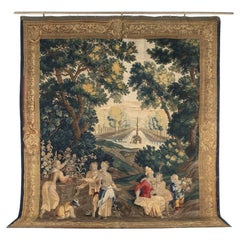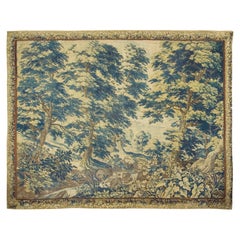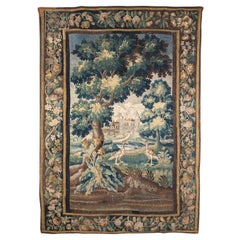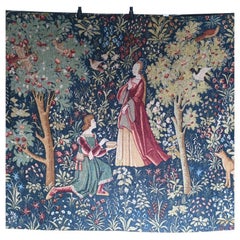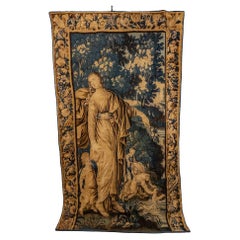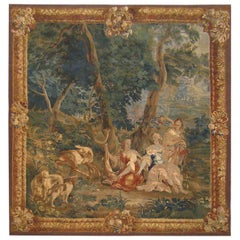18th Century and Earlier Tapestries
to
127
573
178
776
Height
to
Width
to
69
12
8
7
5
4
2
1
1
776
748
1,831
1,152
312
943
438
48
5
49
39
42
101
147
170
62
21
753
571
212
77
68
439
203
197
196
195
776
776
776
38
11
6
4
4
Period: 18th Century and Earlier
Large Early 18th Century Flemish Tapestry
By Guillaume Wernier
Located in Gloucestershire, GB
An early 18th Century Flemish tapestry woven in Lille by Guillaume Werniers. The flower vendor and his young assistants offer their flowers to the local nobility, the background of a...
Category
French Country Antique 18th Century and Earlier Tapestries
Materials
Tapestry
Antique Flemish Verdure Tapestry 9'6 x 12'2
Located in New York, NY
Antique flemish verdure tapestry, 9'6 x 12'2. This antique Flemish tapestry, probably from Brussels is a pure verdure, no humans, just one bird and no animals disturb the sylvan tran...
Category
Dutch Antique 18th Century and Earlier Tapestries
Materials
Wool
French Louis XIV Verdure Tapestry, Aubusson, 1680
Located in Rome, IT
A fine Louis XIV verdure tapestry, Aubusson woven with a wooded river landscape with view of neighboring chateaux, in good four-side floral border.
Measure: cm 200 x 300.
France, sec...
Category
Belgian Louis XIV Antique 18th Century and Earlier Tapestries
Materials
Wool
French Tapestry Lady and Unicorn Mille-Fleurs Woven Wall Covering
Located in Potters Bar, GB
You are viewing a gorgeous French tapestry of 'The Lady and The Unicorn'
Hand woven and amazingly detailed - good size at over five feet wide - 160 CM
Great as a wall hanging
To the ...
Category
French Provincial Antique 18th Century and Earlier Tapestries
Materials
Fabric
17th Century Flemish Aubusson Tapestry
Located in Houston, TX
The 17th Century Flemish Aubusson Tapestry portraying a woman traveling or walking with her child is a captivating depiction of everyday life...
Category
Belgian Baroque Antique 18th Century and Earlier Tapestries
Materials
Wool, Silk
Antique 18th Century Brussels Mythological Tapestry, with Diana the Huntress
Located in New York, NY
An 18th century Brussels mythological hunting tapestry, size 9' H x 8' W, depicting the Roman goddess of the hunt, Diana, reposing in a forest setting with her attendants, with one h...
Category
Belgian Antique 18th Century and Earlier Tapestries
Materials
Wool, Silk
$44,995 Sale Price
33% Off
Rare Aubusson Pastoral Tapestry, 18th Century
Located in LA CIOTAT, FR
Rare fine 18th century Aubusson tapestry, depicting a rural landscape in which three shepherds watch helplessly as one of their lambs is carried off by an opportunistic wolf. Hand-wo...
Category
French Antique 18th Century and Earlier Tapestries
Materials
Wool, Silk
17th Century Antique Flemish Tapestry 7'4"" X 5'10"
Located in Los Angeles, US
A wall hanging tapestry, simply put, is a textile specifically designed and woven to portray an artistic scene with the intent of hanging it on a wall. Antique tapestries, those that...
Category
Unknown Other Antique 18th Century and Earlier Tapestries
Materials
Wool, Cotton
Flemish Historical Tapestry from the 16th/17th Century
Located in Marbella, ES
A stunning late 16th-century Flemish historical tapestry, possibly from Oudenaarde, woven with rich gold, blue, and green threads. The central field possibly depicts the story of Pom...
Category
Belgian Antique 18th Century and Earlier Tapestries
Materials
Wool
Pair of 16th Century Silk Tapestry Borders from Brussels, H-98.75 Inches
Located in Dallas, TX
A beautiful pair of tapestry fragments, hand-woven in Brussels during the 1500s. At roughly 99 inches (over 8 feet) long, the fragments were, originally, vertical borders to a large ...
Category
Belgian Renaissance Antique 18th Century and Earlier Tapestries
Materials
Silk
17th c. French Aubusson Tapestry Fragment
By Isaac Moillon
Located in Wichita, KS
French Baroque tapestry fragment depicting a scene from Greek mythology, Poseidon and Amphitrite, circa 1690. Attributed to Isaac Moillon, Pari...
Category
French Baroque Antique 18th Century and Earlier Tapestries
Materials
Tapestry
18th Century French Aubusson Tapestry
Located in Gloucestershire, GB
A large 18th Century French Aubusson verdure tapestry.
Lots of lush, verdant foliage frames the view on to castle ruins.
The tapestry is in good condition, with all its borders intac...
Category
French Antique 18th Century and Earlier Tapestries
Materials
Tapestry
Huge early 1700's Verdure Aubusson Tapestry
Located in LYON, FR
French Aubusson woven tapestry from the early 1700's depicting a lizard standing in luscious vegetation. Created in Aubusson, located in central France. Interestingly this vertical w...
Category
French Aubusson Antique 18th Century and Earlier Tapestries
Materials
Wool, Silk
18th Century French Tapestry 11'4" X 10'2"
Located in Los Angeles, US
A wall hanging tapestry, simply put, is a textile specifically designed and woven to portray an artistic scene with the intent of hanging it on a wall. Antique tapestries, those that...
Category
Unknown French Provincial Antique 18th Century and Earlier Tapestries
Materials
Wool, Cotton
Antique 17th Century Flemish Tapestry 7'11" X 5'9"
Located in Los Angeles, US
A wall hanging tapestry, simply put, is a textile specifically designed and woven to portray an artistic scene with the intent of hanging it on a wall. Antique tapestries, those that...
Category
Unknown Other Antique 18th Century and Earlier Tapestries
Materials
Wool, Cotton
18th Century Flemish Verdure Tapestry
Located in New York, NY
A Flemish verdure landscape tapestry panel from the 18th century, featuring a verdant scene with large trees and various foliage and including a lake. Enclosed within a stylized bord...
Category
European Antique 18th Century and Earlier Tapestries
Materials
Wool
$11,995 Sale Price
46% Off
15th Century Antique Brussels Millefleur Tapestry 6' X 5'
Located in Los Angeles, US
A wall hanging tapestry, simply put, is a textile specifically designed and woven to portray an artistic scene with the intent of hanging it on a wall. Antique tapestries, those that...
Category
Unknown Other Antique 18th Century and Earlier Tapestries
Materials
Wool, Cotton
Verdure Tapestry From Flanders From The 17th Century
Located in Brussels, Brussels
Very beautiful tapestry describing a verdure from the end of the 17th century/beginning of the 18th century from the Flanders
Elegant tapestry representing a deer and a doe in the f...
Category
Belgian Louis XIV Antique 18th Century and Earlier Tapestries
Materials
Wool
French Antique Tapestry Deer Floral Hand Woven Verdure
Located in Potters Bar, GB
You are viewing an intricate French tapestry showing a stag amongst foliage and flowers
Great colour scheme with blues and pinks
Good size at over four feet wide - 124 CM
Would make for a great wall hanging and would elevate any interior This is a richly detailed verdure tapestry, a style of decorative wall hanging that was especially popular in 16th and 17th century Flanders and Frances
The tag on the back reads:
'This tapestry reproduction...
Category
French Provincial Antique 18th Century and Earlier Tapestries
Materials
Fabric
Late 17th Century French Aubusson Tapestry
Located in New York, NY
A French Aubusson Biblical tapestry from the late 17th century, depicting King Solomon and the Queen of Sheba seated on a throne at center, flanked on either side by attendants, to t...
Category
French Aubusson Antique 18th Century and Earlier Tapestries
Materials
Wool
Early 18th Century Needlework Picture Depicting Angels
Located in Chelmsford, Essex
Early 18th Century Antique Silkwork Embroidery Picture. The embroidery is worked in silk on linen ground, in tent stitch or petit point. Colours pinks, blues, cream, gold, greens and...
Category
Antique 18th Century and Earlier Tapestries
Materials
Silk
17th Century Flemish Verdure Landscape Tapestry, with Trees, Bushes and Flowers
Located in New York, NY
A Flemish verdure landscape tapestry from the 17th century, depicting verdant hills with two large blossoming trees in the foreground, a stream and a large domicile in the middle gro...
Category
European Antique 18th Century and Earlier Tapestries
Materials
Wool, Silk
$7,996 Sale Price
20% Off
17th Century Antique Tapestry 7'9" X 3'2"
Located in Los Angeles, US
A wall hanging tapestry, simply put, is a textile specifically designed and woven to portray an artistic scene with the intent of hanging it on a wall. Antique tapestries, those that...
Category
Unknown Other Antique 18th Century and Earlier Tapestries
Materials
Wool, Cotton
18th Century Flemish Verdure Landscape Tapestry
Located in New York, NY
A Flemish verdure tapestry from the 18th century, depicting two exotic birds within a profuse landscape, with acanthus plants in the foreground, bloomin...
Category
European Antique 18th Century and Earlier Tapestries
Materials
Wool
$69,996 Sale Price
30% Off
Antique 17th Century Flemish Historical Tapestry, Featuring Dido and Aeneas
Located in New York, NY
A French Aubusson historical tapestry from the late 17th century, depicting Aeneas relating his adventures to Dido, from 'The Story of Dido and Aeneas'...
Category
Belgian Antique 18th Century and Earlier Tapestries
Materials
Wool, Silk
$44,995 Sale Price
50% Off
Zabihi Collection Late 18th Century Flemish Verdure Tapestry
Located in New York, NY
a late 18th century Flemish Vedure Tapestry
Measures: 7'4'' wide x 9' long.
Tapestries make integral part of the Flemish cultural heritage. Most of the tapestries have religious, m...
Category
French French Provincial Antique 18th Century and Earlier Tapestries
Materials
Wool
Large 17th Century Flemish Tapestry with Court Scene and Original Border
Located in Atlanta, GA
Large 17th Century Flemish Tapestry with Court Scene and Original Border
Category
Antique 18th Century and Earlier Tapestries
Materials
String
17th Century Antique French Beauvais Grotesque Tapestry
Located in New York, NY
17th century French grotesque tapestry
An antique French Beauvais tapestry from the 17th century, depicting a Grotesque scene with an Elephant and ...
Category
French Antique 18th Century and Earlier Tapestries
Materials
Wool
$240,000 Sale Price
20% Off
A Flemish Verdure Tapestry, 18th Century
Located in ARMADALE, VIC
A Flemish Verdure Tapestry, 18th Century
Depicting a woodland scene, with a large tree in the foreground and a city in the far background.
Provenance: Private Australian Collection...
Category
Belgian Antique 18th Century and Earlier Tapestries
Materials
Wool
Pair of 18th C. French Tapestry Panels with Cherubs
Located in Los Angeles, CA
Pair of 18th C. tapestry panels featuring intricate and richly detailed designs. They display classical motifs, including large architectural elements resembling columns adorned wit...
Category
French Baroque Antique 18th Century and Earlier Tapestries
Materials
Wool
Roman Triumph - Fine Brussels Tapestry from 16th Century - 355lx300h - No. 1507
Located in Paris, FR
Manufacture Des Bruxelles
Epoque: 16th century
Style: Rome and Ancient Greece
Condition: Perfect condition
Material: Wool & Silk
Width: 355 cm
Height: 300 cm
Depth: 0.5 cm
Roman Tri...
Category
Belgian French Provincial Antique 18th Century and Earlier Tapestries
Materials
Wool, Silk
Circa 1590 Flemish Brussels Tapestry Castle King Holy war Hours sword wool silk
By Flemish
Located in Paris, FR
Dans le respect des traditions, cette magnifique tapisserie a été soumise à un nettoyage en profondeur, à la pose d'une doublure en lin cousue à la main, et à une vérification minuti...
Category
French Aubusson Antique 18th Century and Earlier Tapestries
Materials
Wool, Silk
Fine and Rare Pastoral Aubusson Tapestry, France 18th Century
Located in LA CIOTAT, FR
This exquisite rare 18th-century Aubusson tapestry beautifully captures the refined elegance and pastoral charm associated with the Louis XV period. Masterfully woven, it depicts a r...
Category
French Louis XV Antique 18th Century and Earlier Tapestries
Materials
Wool, Silk
Late 17th Century French Aubusson Allegorical Tapestry
Located in New York, NY
A French Aubusson “Louis XIV” allegorical tapestry from the late 17th or early 18th century, depicting an allegory of Spring, with Flora crowned b...
Category
French Aubusson Antique 18th Century and Earlier Tapestries
Materials
Wool
$74,995 Sale Price
50% Off
Pair of Antique Late 17th C. French Aubusson Tapestry Portière Border Panels
Located in New York, NY
Called portière, these antique wall hanging tapestries were handwoven in Aubusson, France in the late 17th Century (c 1680s). They both feature floral and foliage decor in a beige pa...
Category
French Aubusson Antique 18th Century and Earlier Tapestries
Materials
Wool
$6,800 Sale Price / set
20% Off
18th C. French Hand Woven Aubusson Tapestry with Birds, Ruins, and Floral Border
Located in Dallas, TX
This exquisite antique tapestry was handwoven in Aubusson, France, circa 1760, and exemplifies the refined artistry and technical mastery for which this historic weaving center is ce...
Category
French Louis XV Antique 18th Century and Earlier Tapestries
Materials
Tapestry, Canvas
18th.C Antique Flemish Tapestry Historical King Solomon Scene 7'x8' 196cmx244cm
Located in New York, NY
18th.C Antique Flemish Tapestry Historical King Solomon Scene 7'x8' 196cm x 244cm
7x8 ft.
196cm x 244cm
"This is a very fine high quality rare authentic Antique Flemish Tapestry ...
Category
Belgian Antique 18th Century and Earlier Tapestries
Materials
Wool, Silk
Late 16th Century Brussels Historical Tapestry, with Famed Roman General Scipio
Located in New York, NY
A Brussels historical tapestry, attributed to Martin Reymbouts, late 16th century. From the Story of Scipio series, the renowned Roman general, victorious after the Punic War, with k...
Category
Belgian Antique 18th Century and Earlier Tapestries
Materials
Wool
$149,995 Sale Price
25% Off
17th century Aubusson tapestry - the rest after the harvest - N° 1331
Located in Paris, FR
Piece of collectionTapestry 17th century Aubusson - the rest after the harvest
Close to the Eiffel Tower, We are a family business specialized in the purchase, sale and expertise of
tapestries, carpets, kilims and textiles old, modern and contemporary.
We work for private clients, amateurs, antique dealers...
Category
French Aubusson Antique 18th Century and Earlier Tapestries
Materials
Wool
16th Century English Tapestry
Located in LYON, FR
Very rare 16th Century English tapestry. Hand made my candle light over 300 years ago.
Recently professionally cleaned and in good condition.
Sources in Lyon France
Any questions p...
Category
English Medieval Antique 18th Century and Earlier Tapestries
Materials
Wool
18th Century Aubusson Verdure Tapestry
Located in Los Angeles, CA
18th Century European Hand-Woven Aubusson Verdure Tapestry depicting a woodland nature scene. Made in France circa 18th Century. Finely woven with cloth backing.
Category
French Antique 18th Century and Earlier Tapestries
Materials
Tapestry, Wool
Flemish Tapestry 17th Century - Greenery With Owl - H2m70xl2m25 - N° 1430
Located in Paris, FR
Flemish French Tapestry (Manufactury of Flandres) 17th century - Greenery with Owl - H2m70xL2m25 - No. 1430
Clean, revised and lined with velcro
A stone's throw from the Eiffel Towe...
Category
French Aubusson Antique 18th Century and Earlier Tapestries
Materials
Wool, Silk
Flemish 17th Century Tapestry Titled, Assassination of Alexander the Great
Located in Queens, NY
Antique Flemish (17th Century) rectangular woven tapestry depicting a tumultuous crowd scene of Greek militia bordered by a dense floral decoration, titled "The Assassination of Alex...
Category
European Biedermeier Antique 18th Century and Earlier Tapestries
Materials
Wood
Antique 16th Century Flemish Tapestry 3'1" X 1'3"
Located in Los Angeles, US
A wall hanging tapestry, simply put, is a textile specifically designed and woven to portray an artistic scene with the intent of hanging it on a wall. Antique tapestries, those that...
Category
Unknown Other Antique 18th Century and Earlier Tapestries
Materials
Wool, Cotton
Brussels Late 17th Century Tapestry Asia from a Four Continents Series 9'4 x 18
Located in New York, NY
Brussels late 17th century tapestry, "Asia" from a Four Continents series. Designed by Lodowijk van Schoor, Woven in the Workshop of J. van der Borcht I Size: 9'4 high x 18' wide.
Wool, silk and metal thread pattern wefts
This extremely colorful and attractive late Baroque Flemish tapestry with a popular iconography is the product of two important figures in 17th century Brussels weaving. J. van der Borcht I (circa 1650–1713) was a master weaver and tapestry entrepreneur who established a most distinguished family tapestry firm and was followed by J. van der Borcht II, Jasper van der Borcht, Pieter van der Borcht and Jan Frans van der Borcht, taking the operations into the mid18th century. Their wealthy patrons allowed the firm to engage some of the best designers and as a result the artistic quality, as well as the sheer technical execution, is always high. The Van der Borchts wove tapestry series (or single pieces) of Mythological Scenes, Months, Allegories, Armorials, Triumphs of the Gods, The Continents, as well as more down-to-earth genre scenes designed or inspired by David Teniers II or Teniers III.
Their artist designers included, besides the Teniers, Jan van Orley, Augustin Coppens, Gerard Lairesse, Phillipe de Hondt, and the Antwerp-born Lodowijk van Schoor (circa 1650–1702), the designer of U-1362. Van Schoor was the successor of David Teniers III. He was the designer or co-creator of about fifteen sets of tapestries. His cartoons were utilized and copied in both the Northern and Southern Netherlands, and continued popular well into the 18th century. His style, especially in his later works, is more harmonious and refined than Teniers and he avoided genre scenes with peasants. Van Schoor sometimes collaborated with other artists, for example Lucas Aertschellinck (1620 – 1699) who specialized in landscape backgrounds as in the set of Mythological Scenes” woven circa 1700 in the Van der Borcht shop. He did not collaborate on this tapestry, Van Schoor’s figures are graceful and his color schemes vivid, in keeping with the best of contemporary Flemish tapestry. Van Schoor’s designs influenced artists working at great remove from Brussels, even so far as the Florentine workshop of Bernini and Demignot where a Van Schoor inspired “Four Continents” set was woven in the early 1720s.
The “Four Continents” or “Four Parts of the World” was a popular theme in the 17th and 18th centuries for tapestry patrons. Each continent was identified by native peoples and animals: America (North and South together) by Indians and the Turkey bird...
Category
Belgian Antique 18th Century and Earlier Tapestries
Materials
Wool
Antique Square 16th Century Gold Brown Flemish Renaissance Tapestry Nobleman
Located in New York, NY
Tapestries were ubiquitous in the castles and churches of the late medieval and Renaissance eras. At a practical level, they provided a form of insulation and decoration that could be easily transported. In addition, the process of tapestry weaving, where every stitch is placed by hand, enabled the creation of complex figurative images on an enormous scale.
This is an excellent example of 16th century Flemish Renaissance Tapestry...
Category
Belgian Renaissance Antique 18th Century and Earlier Tapestries
Materials
Tapestry, Silk, Wool
Antique Tapestry - Size: - SIze: 11'9x9'2
Located in Los Angeles, CA
Antique Tapestry Rug in Wool and Cotton 11'9x9'2
Key Details:
Pile: Wool
Foundation: Cotton
Origin: Tapestry
Design: Pictorial
Approximate Age: 16th century
Quality (KPI): 3...
Category
French Antique 18th Century and Earlier Tapestries
Materials
Wool, Cotton
17th Century Antique Tapestry with Woodland Scene and Floral Border in Blue Tone
Located in Atlanta, GA
Late 17th century antique tapestry with woodland scene and floral border, rug 17-0401, country of origin / type: France / Adam style t...
Category
French Aubusson Antique 18th Century and Earlier Tapestries
Materials
Wool
16th Century Antique Flemish Tapestry. 11 ft 4 inx12 ft 10in
Located in New York, NY
16th Century Antique Flemish King Solomon Tapestry, Country Of Origin: Belgium, Circa Date: 16th Century. Size: 11 ft 4 in x 12 ft 10 in (3.45 m x 3.91 m)
Category
Belgian Renaissance Antique 18th Century and Earlier Tapestries
Materials
Wool, Silk
17th Century Flemish Tapestry Panel
Located in Canterbury, GB
A Flemish Figural Tapestry Panel
Dating from late 17th century
Hand woven in naturally dyed wools and silks
Depicting a Maiden playing a musical instrument within a garden setting...
Category
Dutch Antique 18th Century and Earlier Tapestries
Materials
Wool
17th Century Brussels Silk and Wool Tapestry Depicting a Roman Scene
Located in Dallas, TX
Hand-woven in the 1600s in Brussels, Belgium, this silk and wool tapestry depicts a citizen paying homage to a Roman general. During the 17th century, Brussels tapestries were highly...
Category
Belgian Antique 18th Century and Earlier Tapestries
Materials
Wool, Linen, Silk
Huge 17th C. Regal Flemish baroque Historical tapestry Royal court Antique LA CA
Located in West Hollywood, CA
Huge 17th C. Regal Flemish baroque Historical tapestry Royal court Antique LA CA . The period followed Renaissance and preceded Rococo and Neoclassical styles. The movement exuberant...
Category
Belgian Antique 18th Century and Earlier Tapestries
Materials
Wool, Silk, Paint
$127,200 Sale Price
20% Off
Large Antique 17th Century Brussels Religious Tapestry
By Flemish
Located in New York, NY
This is a large gorgeous Large Antique 17th Century Brussels Religious Tapestry depicting a scene with a bishop and attendants standing on the right, along with kneeling and standing...
Category
Belgian Baroque Antique 18th Century and Earlier Tapestries
Materials
Tapestry, Wool
17th Century Antique Brussels Tapestry 2'8" X 1'11'
Located in Los Angeles, US
A wall hanging tapestry, simply put, is a textile specifically designed and woven to portray an artistic scene with the intent of hanging it on a wall. Antique tapestries, those that...
Category
Unknown Other Antique 18th Century and Earlier Tapestries
Materials
Wool, Cotton
Two Framed Pre-Columbian Textile Fragments Nazca Culture
Located in Atlanta, GA
Two small fragments of pre-Columbian textiles in shadow box frames. Both have strong geometrical patterns in the style of Nazca culture, located in the southern coast of nowadays Per...
Category
South American Pre-Columbian Antique 18th Century and Earlier Tapestries
Materials
Wool
Ancient Coptic Textile with Classical Figures
Located in Spring Valley, NY
Finely woven of wool and linen, this large, ancient, museum level Coptic textile depicts figures derived from classical antiquity, some playing musical ...
Category
Egyptian Classical Roman Antique 18th Century and Earlier Tapestries
Materials
Wool, Linen
$12,950 Sale Price
30% Off
Venus Visiting Vulcan, Achilles Brussels Tapestry Atelier Van Der Borcht - 1455
Located in Paris, FR
Venus Visiting Vulcan, Achilles - Brussels Tapestry, Atelier Van Der Borcht No. 1455
Artist: In the Taste of Jan Van Orley (1488 – 1541)
Period: 18th century
Style: mythological
Cond...
Category
French Antique 18th Century and Earlier Tapestries
Materials
Wool, Silk
$70,289 Sale Price
20% Off
17th Century Fine Flemish Tapestry, Silk & Wool, Green, Blue, Red, Battle Scene
Located in Port Washington, NY
The tapestry shown here is a magnificent example of 17th-century European artistry, likely influenced by the grand tradition of tapestry weaving that flourished in France and Flander...
Category
French French Provincial Antique 18th Century and Earlier Tapestries
Materials
Wool, Silk
$79,199 Sale Price
20% Off
17th Century Franco-Flemish Mythological Tapestry, with Diana and Fishermen
Located in New York, NY
A Franco-Flemish mythological harvest tapestry from the 17th century, featuring the Roman goddess of the hunt, Diana, aiding people who are fishing in...
Category
French Antique 18th Century and Earlier Tapestries
Materials
Wool
$21,995 Sale Price
26% Off
17th Century Monumental Tapestry/Gobelin Audience with the King in Antiquity
Located in Berlin, DE
17th Century Monumental Tapestry/Gobelin Audience with the King in Antiquity
Extremely beautiful antique Gobelein tapestry, France probably arou...
Category
French Antique 18th Century and Earlier Tapestries
Materials
Wool, Silk
Recently Viewed
View AllMore Ways To Browse
Chinese Blue And White Foo Dogs
Chinese Bronze Wine Vessel
Chinese Collar Framed
Chinese Farmer Painting
Chinese Porcelain Brush Pot
Chinese Sancai Horse
Chinese Temple Bells
Chinese Warrior Statues
Chinese White Porcelain Figurines
Chinoiserie Bombe
Chinoiserie Paper Mache
Christmas Nativity
Christofle Shaker
Christophe Delcourt
Chrome And Glass Drinks Trolley Cart
Circa 1900 India Silver
Cloisonne Fish Vase
Cloisonne Tea Set
